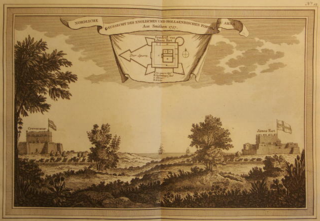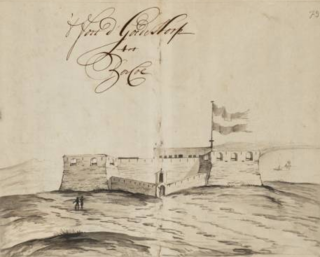
Keta is a coastal town in the Volta Region of Ghana. It is the capital of the Keta Municipal District.

Cape Coast Castle is one of about forty "slave castles", or large commercial forts, built on the Gold Coast of West Africa by European traders. It was originally a Portuguese "feitoria" or trading post, established in 1555, which was named Cabo Corso.

Osu Castle is a castle located in Osu, Ghana, on the coast of the Gulf of Guinea in Africa.

Fort Coenraadsburg or Conraadsburg, also Fort São Tiago da Mina, is a small Portuguese chapel built in honor of Saint Jago and it is situated opposite the Elmina Castle in the Central region of Ghana, to protect Fort Elmina from attacks. Owing to its historical importance and testimony to the Atlantic slave trade, Fort Conraadsburg was inscribed on the UNESCO World Heritage List in 1979 along with several other castles in Ghana.

Ussher Fort is a fort in Accra, Ghana. It was built by the Dutch in 1649 as Fort Crèvecœur, and is two days' march from Elmina and to the east of Accra on a rocky point between two lagoons. It was one of three forts that Europeans built in the region during the middle of the 17th century. Fort Crèvecœur was part of the Dutch Gold Coast. The Anglo-Dutch Gold Coast Treaty (1867), which defined areas of influence on the Gold Coast, transferred it to the British in 1868. Because of its significance in the history of European colonial trade and exploitation in Africa, the fort was inscribed on the UNESCO World Heritage List in 1979.

Fort Amsterdam is a former slave fort in Abandze, Central region, Ghana. It was built by the English between 1638 and 1645 as Fort Cormantin or Fort Courmantyne, and was captured by admiral Michiel de Ruyter of the Dutch West India Company in 1665, in retaliation for the capture of several Dutch forts by the English Admiral Holmes in 1664. It was subsequently made part of the Dutch Gold Coast, and remained part of it until the fort was traded with the British in 1868. The Fort is located at Abandze, on the north-east of Cape Coast in the Mfantseman District of the Central Region of Ghana. Because of its testimony to European economic and colonial influence in West Africa and its historical importance in the Atlantic slave trade, the fort was inscribed on the UNESCO World Heritage List in 1979 along with other forts and castles in Ghana.

Fort São Sebastião located in Shama, Ghana, is the third oldest fortification in Ghana. Along with several other castles in Ghana, it was inscribed on the UNESCO World Heritage List in 1979 because of its testimony to the history of European trade, colonization, and exploitation in the region.

Fort Orange was built as a trading post on the Dutch Gold Coast in 1642, near Sekondi in the Western Region of Ghana. It functioned as a lodge for a while during the 1670s and that was the original purpose for the fort before it was used as a trading post. The trading post was enlarged into a fort in 1690. It was joined by an English Fort Sekondi in 1682. It was sold with the rest of the Dutch Gold Coast to the United Kingdom in 1872, and now serves as a lighthouse. Because of its historical importance in trade between Europe and Africa, Fort Orange was inscribed on the UNESCO World Heritage List in 1979 along with several other castles and forts in Ghana.

Fort Vredenburgh was a Dutch fort on the Gold Coast, established on the left bank of the Komenda River. The fort exists as preserved ruins. Because of its testimony to European economic and colonial influence in West Africa, the fort was inscribed on the UNESCO World Heritage List in 1979, along with other nearby forts and castles.

Fort de Goede Hoop or Fort Good Hope was a fort on the Dutch Gold Coast, established in 1667 near Senya Beraku.
Anloga is a town in Keta District of the Volta Region in southeast Ghana. It lies east of the Volta River and just south of the Keta Lagoon. Anloga is the forty-seventh most populous town in Ghana, in terms of population, with a population of 35,933 people.

Fort William is a fort in Anomabu, Central Region, Ghana, originally known as Fort Anomabo and renamed Fort William in the 1830s by its then-commander, Brodie Cruickshank, who added one storey to the main building, and renamed the fort after King William IV.

Fort James is a fort located in Accra, Ghana. It was built by the Royal African Company of England (RAC) as a trading post for both gold and slaves in 1673, where it joined the Dutch Fort Crêvecœur (1649), and the Danish Fort Christiansborg (1652) along the coast of the then Gold Coast. Along with other castles and forts in Ghana, Fort James was inscribed on the UNESCO World Heritage List in 1979 because of its importance during the European colonial period.

Fort Apollonia is a fort in Beyin, Ghana. The name Apollonia was given to the area by a Portuguese explorer who sighted the place on the Feast of Saint Apollonia, 9 February. Because of its importance during the European colonial period and its testimony to the Atlantic slave trade, Fort Apollonia was inscribed on the UNESCO World Heritage List along with several other forts and castles in Ghana in 1979.

Fort Komenda was a British fort on the Gold Coast, currently preserved as a ruin. Because of its testimony to the Atlantic slave trade and European economic and colonial influence in West Africa, the fort was inscribed on the UNESCO World Heritage List in 1979, along with several other castles and forts in Ghana.

Fort Frederiksborg, later Fort Royal, was a Danish and later English fort on the Gold Coast in contemporary Ghana. It was built in 1661, with the approval of the King of Fetu, a few hundred yards from Cape Coast Castle, which was at that time in Swedish hands, on Amanfro Hill. Along with several other castles and forts nearby, Fort Frederiksborg was inscribed on the World Heritage List in 1979 because of its testimony to European economic influence on West Africa and the Atlantic slave trade.
Alakple is a town in the Keta Municipality of the Volta Region of Ghana. This town is situated along the south western part of the Keta lagoon. The bust of the prominent African American boxer Muhammad Ali is planted at the junction along the Anloga and Dabala road. That road leads to Alakple. This town is prominent for the historical role it plays in the area. It is the home of the Nyigbla, 'god of war' who rode on horseback. The major clan in the town is Ameawo who are the custodians or clan responsible for nugbidodo 'settling disputes'. They are also believed to have control of all palm trees in Anloland. As custodians of Torgbi Nyigbla there are many taboos related to their dressing and food. for instance they are forbidden to wear shirts or blouse and sandals within the shrine.

Fort Vernon was a military structure designed to facilitate the Atlantic slave trade. The Royal African Company built the fort in 1742 near Prampram, a town in the Greater Accra Region of Ghana. It was built out of cheap materials – rough stones and swish. The Danes destroyed the fort before 1783. The British rebuilt it in 1806, but it soon started to collapse and was abandoned in about 1816. It was re-occupied by the British in 1831 but was again abandoned in 1844. It subsequently became ruins. Because of its importance during the slave trade and its testimony to European economic and colonial influence in West Africa, the fort was inscribed on the UNESCO World Heritage List in 1979, along with several other forts and castles in Ghana.

Fort Fredensborg is situated along the Gulf of Guinea, in the Greater Accra Region in Old Ningo and was built in 1734. Because of its testimony to the Atlantic slave trade and the European colonial influence on West Africa, the fort was inscribed on the UNESCO World Heritage List in 1979, along with several castles and forts in Ghana.



























